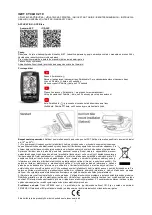
75
b
c
d
a
Fitness and mountain bikes are not suitable for mounting a
child carrier with special fittings. For more information on other
bicycle types, see chapter
“Intended Use”
. Consult a bicycle
specialist shop of your trust.
Make it a rule to take your child out of the carrier when parking
the bicycle.
Risk of toppling ove
r!
Cover the springs of your saddle so that the child cannot get his
or her fingers pinched between them.
Make sure the child you are taking with you wears a helmet!
It is recommendable to only buy a DIN or GS tested child carrier. Be sure
to fasten the child’s seat belt before you set off and make sure the feet
are properly seated in the shields
(b)
.
Child carriers have a strong influence on the bicycle’s riding characteris
-
tics. The weight of both carrier and child will make the bicycle somewhat
top-heavy and tend to give you a wobbly ride. Practise getting on and
riding your bicycle with a child on it!
A critical moment is when you have just placed the child in the carrier
because this is when the danger of the bicycle toppling over is greatest.
A good way to obviate this danger is to use a twin leg kickstand to keep
the bicycle stable in standing.
Children must be transported in special child carriers only that
provide sufficient protection for their feet. Please inform your
-
self about the situation in your country!
12.2.2 child Trailers.
With special child trailers
(c+d)
that are towed behind a bicycle you can
transport one or two children. Children can play in the trailer without the
danger of toys falling out. Some models provide the option of mounting a
sunshade or rain shield.
Before hitching a trailer to your bicycle have a look at chapter
“Intended Use”
or contact a bicycle specialist shop of your
trust. Note down the trailer type you opt for so that they can
provide you with the information you need.
















































